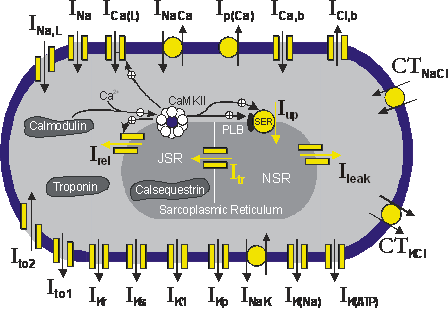The
Hund-Rudy Dynamic (HRd) Model of the Canine Ventricular Myocyte
|
|
The Hund-Rudy dynamic (HRd) model is based on data from the canine epicardial ventricular myocyte. Rate-dependent phenomena associated with ion channel kinetics, action potential properties and Ca2+ handling are simulated by the model. Distinguishing features of the HRd include (1) regulation of Ca2+-handling by Ca2+/calmodulin dependent protein kinase (CaMKII), (2) incorporation of the late Na+ current (INaL) and Ca2+ dependent transient outward current (Ito2, in addition to Ito1), (3) dynamic intracellular Cl- handling and (4) a novel formulation of calcium release from the junctional sarcoplasmic reticulum (JSR). Interaction between dihydropyridine receptors (ICaL) and ryanodine receptors (RyR) occurs in a restricted Ca2+ subspace. The calcium release formulation incorporates activation of RyR by ICaL, Ca2+-dependent inactivation of RyR, and modulation of RyR open-probability by both JSR and subspace Ca2+. |
Originally published in:
"Rate dependence and regulation of action potential and calcium
transient
in a canine cardiac ventricular cell model."
Hund TJ, Rudy Y.
Circulation.
2004 Nov 16;110(20):4008-74.
ERRATUM:
In the online supplement for the HRD code, there is a typo in the
formulation of the Na+ current rate constant ![]() . The equation should read:
. The equation should read:
If ![]() mV,
mV,

SIMULATION NOTES :
Note on achieving steady state during ultra-long term continuous pacing.
Note on modifications to HRD code for simulation of propagation.
|
|
To directly access the C++ code, (Last updated on September 29, 2005) click here . |
|
|
To download the Matlab code,
(Last updated on October 5, 2005. Backward
Compatibility with Matlab 6.5) click here . |
|
|
For sample output, and directions on how to use the code click here. |
|
|
To view a concise description of the model formulations, click here. |
|
|
Question about the model? Email Tom Hund. Question
about the code? Email Keith Decker |
Linked
Index to the C++ Code and Descriptions of Formulations
|
A. Currents |
Variable |
Formulation |
Code |
|
|
1. fast Na+ current |
ina |
|||
|
2. late Na+ current |
inal |
|||
|
3. L-type Ca2+ current |
ical |
|||
|
4. rapid delayed rectifier K+ current |
ikr |
|||
|
5. slow delayed rectifier K+ current |
iks |
|||
|
6. 4AP-sensitive transient outward K+ current |
ito1 |
|||
|
7. Ca2+ dependent transient outward Cl- current |
ito2 |
|||
|
8. time- independent K+ current |
ik1 |
|||
|
9. background Ca2+ current |
icab |
|||
|
10. plateau K+ current |
ikp |
|||
|
11. Cl- background current |
iclb |
|||
|
B. Pumps and Exchangers |
|
|
|
|
|
1. Na+-Ca2+ exchanger |
inaca |
|||
|
2. Na+-K+ pump |
inak |
|||
|
3. Sarcolemmal Ca2+ pump |
ipca |
|||
|
C. Transporters |
|
|
|
|
|
1. Na+-Cl- cotransporter |
ctnacl |
|||
|
2. K+-Cl- cotransporter |
ctkcl |
|||
|
D. Ionic Fluxes |
|
|
|
|
|
1. Ca2+ leak from JSR to myoplasm |
qleak |
|||
|
2. Ca2+ release from JSR to subspace |
qrelease |
|||
|
3. Ca2+ transfer from NSR to JSR |
qtr |
|||
|
4. Ca2+ uptake from myoplasm to NSR |
qup |
|||
|
E. Dynamic Concentrations |
|
|
|
|
|
1. myoplasmic Na+ |
nai |
|
||
|
2. myoplasmic K+ |
ki |
|
||
|
3. myoplasmic Cl- |
cli |
|
||
|
4. myoplasmic Ca2+ |
cai |
|
||
|
5. JSR Ca2+ |
cajsr |
|
||
|
6. NSR Ca2+ |
cansr |
|
||
|
7. restricted space Ca2+ |
car |
|
||
|
8. CaMKinase |
camk |
|
